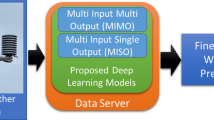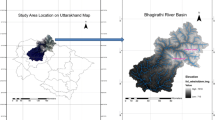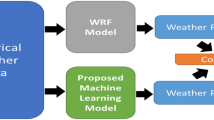Abstract
In this study, the application of artificial intelligence to monthly and seasonal rainfall forecasting in Queensland, Australia, was assessed by inputting recognized climate indices, monthly historical rainfall data, and atmospheric temperatures into a prototype stand-alone, dynamic, recurrent, time-delay, artificial neural network. Outputs, as monthly rainfall forecasts 3 months in advance for the period 1993 to 2009, were compared with observed rainfall data using time-series plots, root mean squared error (RMSE), and Pearson correlation coefficients. A comparison of RMSE values with forecasts generated by the Australian Bureau of Meteorology’s Predictive Ocean Atmosphere Model for Australia (POAMA)-1.5 general circulation model (GCM) indicated that the prototype achieved a lower RMSE for 16 of the 17 sites compared. The application of artificial neural networks to rainfall forecasting was reviewed. The prototype design is considered preliminary, with potential for significant improvement such as inclusion of output from GCMs and experimentation with other input attributes.
Similar content being viewed by others
References
ASCE Task Committee on Application of Artificial Neural Networks in Hydrology, 2000a: Artificial neural networks in hydrology. I: Preliminary concepts. J Hydrol Eng., 5, 115–123.
ASCE Task Committee on Application of Artificial Neural Networks in Hydrology, 2000b: Artificial neural networks in hydrology. II: Hydrological applications. J. Hydrol. Eng., 5, 124–137.
Bilgili, M., and B. Sahin, 2010: Prediction of Long-term Monthly Temperature and Rainfall in Turkey. Energy Sources, 32, 60–71.
Braganza, K., J. L. Gergis, S. B. Power, J. S. Risbey, A. M. Fowler, 2009: A multiproxy index of the El Nino-Southern Oscillation, A. D. 1525–1982. J. Geophys. Res., 114, D05106.
Castellani, L., I. Becchi, and F. Castelli, 1996: Rainfall Frequency and Seasonality Identification through Artificial Neural Networks. Meccanica, 31, 117–127.
Chakraverty, S., and P. Gupta. 2008: Comparison of neural network configurations in the long-range forecast of southwest monsoon rainfall over India. Neural Computing & Applications, 17, 187–192.
Chattopadhyay, S., and G. Chattopadhyay, 2008: Comparative study among different neural net learning algorithms applied to rainfall time series. Meteorological Applications, 15, 273–280.
Day, K. A., D. G. Ahrens, and A. Peacock, 2010: Seasonal Pacific Ocean Temperature Analysis-1 (SPOTA-1) as at November 1, 2010. Report issued by the Queensland Climate Change Centre of Excellence, Queensland Government, Brisbane, Australia, 2pp. [Available online from http://www.longpaddock.qld.gov.au/spota1-getpassword.html]
Elman, J. L., 1990: Finding structure in time. Cognitive Science, 14, 179–211.
Erlykin, A. D., G. Gyalai, K. Kudela, T. Sloan, and A.W. Wolfendale, 2009: On the correlation between cosmic ray intensity and cloud cover. Journal of Atmospheric and Solar-Terrestrial Physics, 71, 1794–1806.
Firth, L., M. L. Hazelton, and E. P. Campbell, 2005: Predicting the Onset of Australian Winter Rainfall by Nonlinear Classification. J. Climate, 18, 772–781.
Freiwan, M., and H. K. Cigizoglu, 2005: Prediction of total monthly rainfall in Jordan using feed-forward back-propagation method. Fresenius Environmental Bulletin, 14, 142–151.
French, M. N., W. F. Krajewski, and R. R. Cuykendall, 1992: Rainfall forecasting in space and time using a neural network. J. Hydrol., 137, 1–31.
Frohlich, C., 2000: Observations of irradiance variations. Space Science Rev., 94, 15–24.
Giles, C. L., S. Lawrence, and A. C. Tsoi, 1997: Rule inference for financial prediction using recurrent neural networks. Proc. IEEE/IAFE Conf. on Computational Intelligence for Financial Engineering, IEEE Press, Piscataway, NJ, 253–259.
Gholizadeh, M. H., and M. Darand, 2009: Forecasting Precipitation with Artificial Neural Networks (Case Study: Tehran). J. Appl. Sci., 9, 1786–1790.
Guhathakurta, P, M. Rajeevan, and V. Thapliyal, 1999: Long range forecasting indian summer monsoon rainfall by a hybrid principal component neural network model. Meteorology and Atmospheric Physics, 71, 255–266.
Hartmann, H., S. Beckerb, and L. King. 2008: Predicting summer rainfall in the Yangtze River basin with neural networks. Int. J. Climatol. 28, 925–936.
Htike, K. K., and O. O. Khalifa, 2010: Rainfall forecasting models using focused time-delay neural networks. Int. Conf. on Computer and Communication Engineering, Kuala Lumpur, Malaysia, 1–6. [Available online at http://dx.doi.org/10.1109/ICCCE.2010.5556806]
Hudson, D., O. Alves, H. H. Hendon, and A. G. Marshall, 2011: Bridging the gap between weather and seasonal forecasting: Intraseasonal forecasting for Australia. Quart. J. Roy. Meteor. Soc. 137, 673–689.
Hurst, D., 2011: Three-quarters of Queensland a disaster zone. Brisbane Times, Fairfax Media. [Available online at http://www.brisbanetimes.com.au/environment/weather/threequarters-of-queensland-adisaster-zone-20110111-19mf8.html].
Iseri, Y., G. C. Dandy, H. R. Maier, A. Kawamura, and K. Jinno, 2005: Medium term forecasting of rainfall using artificial neural Networks. Modelling and Simulation Society of Australia and New Zealand, A. Zerger and R. M. Argent, Eds., 1834–1840.
Johns, T. C., and Coauthors, 2006: The New Hadley Centre Climate Model (HadGEM1): Evaluation of coupled simulations. J. Climate, 19, 1327–1353.
Karamouz, M., S. Razavi, and S. Araghinejad, 2008: Long-lead seasonal rainfall forecasting using timedelay recurrent neural networks: A case study. Hydrological Processes, 22, 229–241.
Kiem, A., S. Franks, and G. Kuczera, 2003: Multi-decadal variability of flood risk. Geophys. Res. Lett., 30(2), 1–7.
Kirkby, J., and Coauthors, 2011: Role of sulphuric acid, ammonia and galactic cosmic rays in atmospheric aerosol nucleation. Nature, 476(7361), 429–435.
Kirono, D. G. C, F. H. S. Chiew, and D. M. Kent 2010: Identification of best predictors for forecasting seasonal rainfall and runoff in Australia. Hydrological Processes, 24, 1237–1247.
Kulshretha, M. S., and R. K. George, 2007: Prediction of annual rainfall by double Fourier series and artificial neural network. Neural, Parallel & Scientific Computations, 15, 539–546.
Laken, B. A., D. R. Kniveton, and M. R. Frogley, 2010: Cosmic rays linked to rapid mid-latitude cloud changes. Atmos. Chem. Phys., 10, 10941–10948.
Long, J., L. Ying, and L. Zhenshan, 1997: Comparison of long-term forecasting of June-August Rainfall over Changjiang-Huaihe Valley. Adv. Atmos. Sci., 14, 87–92.
Luk, K. C., J. E. Ball, and A. Sharma, 2000: A study of optimal model lag and spatial inputs to artificial neural network for rainfall forecasting. J. Hydrol., 227, 56–65.
Luk, K. C., J. E. Ball, and A. Sharma, 2001: An application of artificial neural networks for rainfall forecasting, Mathematical and Computer Modelling., 33, 883–699.
Marshal, A. G., D. Hudson, M. C. Wheeler, H. H. Hendon, and O. Alves, 2011: Simulation and prediction of the Southern Annular Mode and its influence on Australian intra-season climate in POAMA. Climate Dyn.. (in press)
McBride, J. L., and N. Nicholls, 1983: Seasonal relationships between Australian rainfall and the Southern Oscillation. Mon. Wea. Rev., 111, 1998–2004.
Meinke, H., and R. Stone, 2005: Seasonal and interannual climate forecasting: the new tool for increasing preparedness to climate variability and change in agricultural planning and operations. Climate Change., 70, 221–253.
Micevski, T., S. Franks, and G. Kuczera, 2006: Multidecadal variability in coastal eastern Australian flood data. J. Hydrol., 327(1–2), 219–225.
Michaelides, S. C., C. S. Pattichis, and G. Kleovoulou, 2001: Classification of rainfall variability by using artificial neural networks. Int. J. Climatology, 21, 1401–1414.
Mozer, M. C., and P. Smolensky, 1989: Skeletonization: a technique for trimming the fat from a network via relevance assessment. Advances in Neural Information Processing Systems 1, D. Touretzky, ED., Morgan Kaufmann, San Monteo, California, 107–115.
Nasseri, M., K. Asghari, and M. J. Abedini, 2008: Optimized scenario for rainfall forecasting using genetic algorithm coupled with artificial neural network. Expert Systems With ApplicationsS, 35, 1415–1421.
Navone, H. D., and H. A. Ceccatto, 1994: Predicting Indian monsoon rainfall: A neural network approach. Climate Dyn., 10, 305–312.
Nicholls, N, B. Lavery, C. Fredericksen, W. Drosdowsky, and S. Torok, 1996: Recent apparent changes in relationships between the El Nino-southern oscillation and Australian rainfall and temperature. Geophys. Res. Lett., 23, 3357–3360.
Nicholls, N., W. Drosdowsky, and B. Lavery, 1997: Australian rainfall variability and change. Weather, 52, 66–71.
Philip, N. S., and K. B. Joseph, 2003: A neural network tool for analysing trends in rainfall. Comput. Geosc., 29, 215–223.
Pineda, F. J., 1989: Recurrent back-propagation and the dynamical approach to adaptive neural computation. Neural Computation, 1, 161–172.
Power, S., T. Casey, C. Folland, A. Colman, and V. Mehta, 1999: Interdecadal modulation of the impact of ENSO on Australia. Clim. Dynam., 15, 319–324.
Power, S. B., M. Haylock, R. Colman, and X. Wang, 2006: The Predictability of Interdecadal Changes in ENSO Activity and ENSO Teleconnections. J. Climate, 19, 4755–4771.
Queensland Flood Commission of Inquiry, 2011: Queensland Foods Commission of Inquiry: Interim Report, 1180pp. Brisbane, Queensland, Australia. [Available online from www.floodcommission.qld.gov.au]
Rashid, H. A., H. H. Hendon, M. C. Wheeler, and O. Alves, 2011: Prediction of the Madden-Julian oscillation with the POAMA dynamical prediction system. Climate Dyn., 36(3), 649–661.
Risbey, J. S., M. J. Pook, and P. C. McIntosh, 2009: On the remote drivers of rainfall variability in Australia. Mon. Wea. Rev., 137, 3233–3253.
Seqwater. 2011: Report on the operation of Somerset Dam and Wivenhoe Dam: January 2011 Flood Event. Queensland Government, Brisbane, Australia.
Silverman, D., and J. A. Dracup, 2000: Artificial neural networks and long-range precipitation prediction in California. J. Appl. Meteor., 39, 57–66.
Stone, R. C., G. L. Hammer, and T. Marcussen, 1996: Prediction of global rainfall probabilities using phases of the southern oscillation index. Nature, 384, 252–255.
Suppiah, R., 2004: Trends in the southern oscillation phenomenon and Australian rainfall and changes in their relationship. Int. J. Climatol., 24, 269–290.
Tangang, F. T., B. Tang, A. H. Monahan, and W. W. Hsieh, 1998: Forecasting ENSO Events: A neural network-extended EOF approach. J. Climate, 11, 29–41.
Thresher, R. E., 2002: Solar correlates of Southern Hemisphere mid-latitude climate variability. Int. J. Climatol., 22, 901–915.
Tomasino, M., D. Zanchettin, and P. Traverso, 2004: Long-range forecasts of River Po discharges based on predictable solar activity and a fuzzy neural network model. Hydrological Sciences Journal, 49, 673–684.
Ummenhofer, C. C., M. H. England, P. C. McIntosh, G. A. Meyers, Michael J. Pook, J. S. Risbey, A. Sen Gupta, and A. S. Taschetto, 2009: What causes southeast Australia’s worst droughts? Geophys. Res. Lett., 36, L04706.
Vaze, J., J. Teng, and F. H. S. Chiew, 2011: Assessment of GCM simulations of annual and seasonal rainfall and daily rainfall distribution across south-east Australia. Hydrological Processes, 25, 1486–1497.
Venkatesan, C., S. D. Raskar, S. S. Tambe, B. D. Kulkarni, and R. N. Keshavamurty, 1997: Prediction of all India summer monsoon rainfall using error back propagation neural networks. Meteorol. Atmos. Physics, 62, 225–240.
Verdon, D. C., and S. W. Franks, 2006: Long-term behaviour of ENSO: Interactions with the PDO over the past 400 years inferred from paleoclimate records. Geophys. Res. Lett., 33(6), L06712.
Versteegh, G. J. M., 2005: Solar forcing of climate. 2: Evidence from the past. Space Science Reviews., 120, 243–286.
Vines, R. G., 2008: Australian rainfall patterns and the southern oscillation. 2. A regional perspective in relation to Luni-solar (Mn) and Solar-cycles (Sc) signals. Rangeland Journal, 30, 349–359.
Wang, Z., and H. Sheng, 2010: Rainfall Prediction Using Generalized Regression Neural Network: Case study Zhengzhou. Int. Conf. on Computational and Information Sciences, Chengdu, Sichuan, China, 1265–1268.
Wu, X., H. Cao, A. Flitman, F. Wei, and G. Feng, 2001: Forecasting monsoon precipitation using artificial neural networks. Adv. Atmos. Sci., 18, 950–958.
Zhao, M., and H. H. Hendon, 2009: Representation and prediction of the Indian Ocean dipole in the POAMA seasonal forecast model. Quart. J. Roy. Meteor. Soc. 135, 337–352.
Zwiers, F. W., and H. Von Storch, 2004: On the role of statistics in climate research. Int. J. Climatol., 24, 665–680.
Author information
Authors and Affiliations
Corresponding author
Rights and permissions
About this article
Cite this article
Abbot, J., Marohasy, J. Application of artificial neural networks to rainfall forecasting in Queensland, Australia. Adv. Atmos. Sci. 29, 717–730 (2012). https://doi.org/10.1007/s00376-012-1259-9
Received:
Revised:
Published:
Issue Date:
DOI: https://doi.org/10.1007/s00376-012-1259-9




